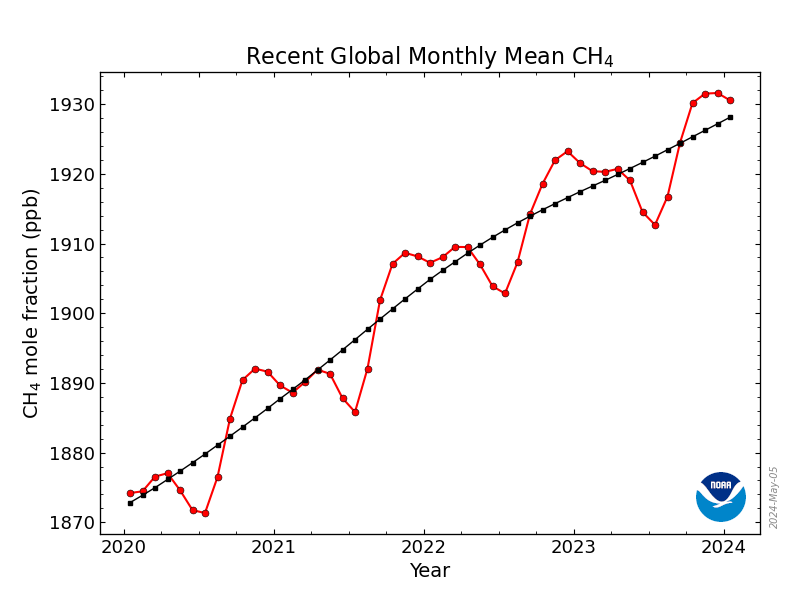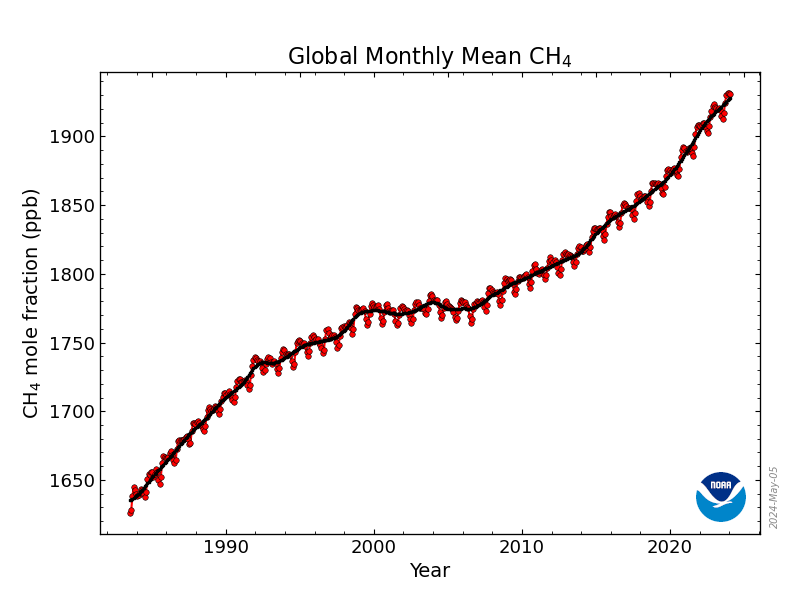Re: The Methane Thread pt. 2
March 2020: 1876.4 ppb
March 2019: 1866.3 ppb
Exploring Hydrocarbon Depletion
https://peakoil.com/forums/
https://peakoil.com/forums/the-methane-thread-pt-2-t71701-360.html


Since 2000 discharges of the odourless, colourless gas have risen by more than 50m tonnes a year, equivalent to 350m cars or double the total emissions of Germany or France, according to the latest Methane Budget study by a global team of scientists.
The findings, published in Earth System Science Data and Environmental Research Letters, show that more than half of the methane in the atmosphere now comes from human sources. Of this share, ranching, agriculture and landfills account for about two-thirds, while the fossil fuel industry, composed of oil, gas and coal, makes up the rest.
In 2017, the most recent year for which data is available, the planet’s atmosphere absorbed almost 600m tonnes of methane, up 9% from the early years of the century when concentrations were relatively stable.
Rob Jackson, a professor at the Stanford University School of Earth, Energy & Environmental Sciences, in California, chairs the Global Carbon Project and led one of the papers. He said human activities since the industrial revolution had increased the amount of methane in the atmosphere by 2.6 times, compared with 1.7 times for carbon dioxide.
As methane is more potent then CO2 and shorter-lived in its climate effects, it should be a focus of efforts to cut emissions, said Jackson.
“CO2 is still the beast to slay but warming from methane is the next most important. Acting aggressively on methane can buy us time to address CO2 and shave half a degree off the peak temperature,” he said. “I am optimistic about opportunities to find methane super-emitters, using drones and satellites. But it is harder to cut emissions from a billion burping cows and a billion sheep, where dietary choices and manure management matter.”
The change is markedly different by sector and location. Agricultural methane emissions rose nearly 11% in the study period, while those from fossil fuels rose 15%.
Regionally, the biggest increases – of 10m to 15m tonnes a year – were in Asia, Africa and Oceania, largely due to farming. In the US most of the 4.5m-tonne rise over the past decade has been attributed to fracking and others forms of oil and gas drilling, piping and consumption.
Europe was the only continent to register a decline thanks to strong measures to reduce emissions from manure and industry. The Arctic also saw little change, suggesting fears of methane being released from melting permafrost had not been realised up to 2017.
The authors said there could not be a worldwide stabilisation in methane emissions unless governments took rapid action.
Plant roots in soil stimulate microbial decomposition, a mechanism called the priming effect. An international research team co-lead by Frida Keuper from INRAE and Umeå University and Birgit Wild from Stockholm University shows that the priming effect alone can cause emission of 40 billion tons carbon from permafrost by 2100. The study was published today in Nature Geoscience.
Scientists have previously anticipated that rapidly rising temperatures will drive the emission of 50-100 billion ton permafrost carbon by 2100. On top of that, plant roots feed sugar to the microorganisms in the soil, which the microbes can use to break down more soil organic matter—the priming effect—resulting in even higher greenhouse gas emissions.
The researchers combined maps of plant activity and data on soil carbon content from the Northern Circumpolar Soil Carbon Database with an extensive literature survey on priming and plant root properties, to estimate the priming effect in permafrost ecosystems and its influence on greenhouse gas emissions.
They show that the priming effect increases soil microbial respiration by 12 percent, which causes the additional loss of 40 billion tons of carbon by 2100 compared to current predictions for permafrost. This equals almost a quarter of the remaining "carbon budget" for human activities to limit global warming to max 1.5°C.
Tanada wrote:
dissident wrote:Tanada wrote:
Interesting how the 2000s warming "stall" shows up in CH4. But if you go back to the 1980s you see that there was an acceleration that peaked in the 1990s that sits on top of a long-term growth trend. This 1980 and 1990s surge is something is hard to explain. Probably some critical point reached from human stressing of forests.
Yes but every NG turbine unit that replaces and old coal burning base plant produces a lot less pollution both CO2 and leaked Methane then the coal plant did.Subjectivist wrote:
From the environmental standpoint they added a whole bunch of new connections to the natural gas network and even the best burner system is not 100% efficient all the time. That means the 1% or so of unburned gas that goes through the turbine is dumped straight into the atmosphere along with whatever tiny leaks develop in all those new pipes.
Russia is fighting a mysterious anthrax outbreak in a remote corner of Siberia. Dozens of people have been hospitalized; one child has died. The government airlifted some families out because more than 2,000 reindeer have been infected.
Plantagenet wrote:Trump's EPA drops regulations designed to reduce methane emissions in the USA
epa-roll-back-methane-emissions-limits]
Just another disgraceful move by the Trump administration, this time having the EPA roll back limits on methane emissions. Meanwhile methane levels in the atmosphere continue to go higher and higher, driving global warming to ever higher levels.
SHEEESH!

The world's peatlands will become a large source of greenhouse gases as temperatures rise this century, say scientists.
Right now, huge amounts of carbon are stored in boggy, often frozen regions stretching across northern parts of the world.
But much of the permanently frozen land will thaw this century, say experts.
This will release warming gases at a rate that could be 30-50% greater than previous estimates.
Using data compiled from more than 7,000 field observations, the authors of this new study were able to generate the most accurate maps to date of the peatlands, their depth and the amount of warming gases they contain.
They show that the boggy terrain covers 3.7 million sq kilometres (1.42 million sq miles)...
If this new peatland estimate is included with all the estimates for permafrost melting, it is projected to equal the annual emissions of the EU and UK by 2100.
"The only way to limit the permafrost carbon feedback is to reduce global warming," said Dr Hugelius.